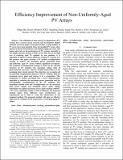| dc.contributor.author | Hu, Yihua | |
| dc.contributor.author | Zhang, Jiangfeng | |
| dc.contributor.author | Wu, Jiande | |
| dc.contributor.author | Cao, Wenping | |
| dc.contributor.author | Tian, Gui Yun | |
| dc.contributor.author | Kirtley, James L., Jr. | |
| dc.date.accessioned | 2016-08-24T20:31:27Z | |
| dc.date.available | 2016-08-24T20:31:27Z | |
| dc.date.issued | 2016-03 | |
| dc.date.submitted | 2016-01 | |
| dc.identifier.issn | 0885-8993 | |
| dc.identifier.issn | 1941-0107 | |
| dc.identifier.uri | http://hdl.handle.net/1721.1/103970 | |
| dc.description.abstract | The utilization of solar energy by photovoltaic (PV) systems have received much research and development (R&D) attention across the globe. In the past decades, a large number of PV array have been installed. Since the installed PV arrays often operate in harsh environments, non-uniform aging can occur and impact adversely on the performance of PV systems, especially in the middle and late periods of their service life. Due to the high cost of replacing aged PV modules by new modules, it is appealing to improve energy efficiency of aged PV systems. For this purpose, this paper presents a PV module reconfiguration strategy to achieve the maximum power generation from non-uniformly aged PV arrays without significant investment. The proposed reconfiguration strategy is based on the cell-unit structure of PV modules, the operating voltage limit of gird-connected converter, and the resulted bucket-effect of the maximum short circuit current. The objectives are to analyze all the potential reorganization options of the PV modules, find the maximum power point and express it in a proposition. This proposition is further developed into a novel implementable algorithm to calculate the maximum power generation and the corresponding reconfiguration of the PV modules. The immediate benefits from this reconfiguration are the increased total power output and maximum power point voltage information for global maximum power point tracking (MPPT). A PV array simulation model is used to illustrate the proposed method under three different cases. Furthermore, an experimental rig is built to verify the effectiveness of the proposed method. The proposed method will open an effective approach for condition-based maintenance of emerging aging PV arrays. | en_US |
| dc.description.sponsorship | Seventh Framework Programme (European Commission) (FP7 HEMOW) | en_US |
| dc.description.sponsorship | European Commission (Marie Curie International Outgoing Fellowship) | en_US |
| dc.language.iso | en_US | |
| dc.publisher | Institute of Electrical and Electronics Engineers (IEEE) | en_US |
| dc.relation.isversionof | http://dx.doi.org/10.1109/TPEL.2016.2544842 | en_US |
| dc.rights | Creative Commons Attribution-Noncommercial-Share Alike | en_US |
| dc.rights.uri | http://creativecommons.org/licenses/by-nc-sa/4.0/ | en_US |
| dc.source | Prof. Kirtley via Phoebe Ayers | en_US |
| dc.title | Efficiency Improvement of Non-Uniformly-Aged PV Arrays | en_US |
| dc.type | Article | en_US |
| dc.identifier.citation | Hu, Yihua, Jiangfeng Zhang, Jiande Wu, Wenping Cao, Gui Yun Tian, and James L. Kirtley. “Efficiency Improvement of Non-Uniformly-Aged PV Arrays.” IEEE Transactions on Power Electronics Volume:PP, Issue: 99 (2016): pp.1-13. | en_US |
| dc.contributor.department | Massachusetts Institute of Technology. Department of Electrical Engineering and Computer Science | en_US |
| dc.contributor.approver | Kirtley, James L., Jr. | en_US |
| dc.contributor.mitauthor | Kirtley, James L., Jr. | en_US |
| dc.relation.journal | IEEE Transactions on Power Electronics | en_US |
| dc.eprint.version | Original manuscript | en_US |
| dc.type.uri | http://purl.org/eprint/type/JournalArticle | en_US |
| eprint.status | http://purl.org/eprint/status/NonPeerReviewed | en_US |
| dspace.embargo.terms | N | en_US |
| dc.identifier.orcid | https://orcid.org/0000-0002-5347-2410 | |
| mit.license | OPEN_ACCESS_POLICY | en_US |
| mit.metadata.status | Complete | |
